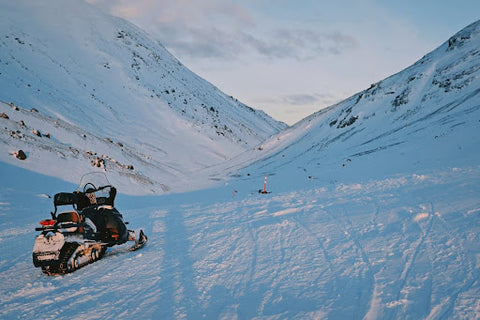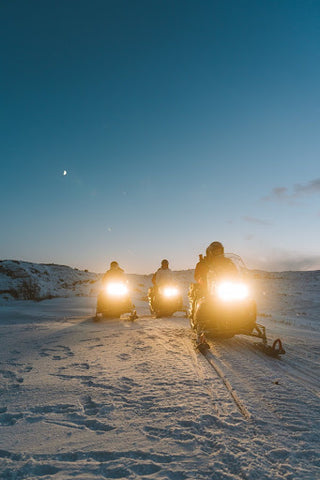Going snowmobiling can be an exhilarating winter activity, but it's important to take precautions to protect yourself from frostbite. Frostbite occurs when the skin and underlying tissues freeze, typically due to prolonged exposure to cold temperatures. To keep yourself safe and warm while enjoying your snowmobiling adventures, here are five essential tips to follow.
Understanding Frostbite: Causes and Symptoms
Frostbite occurs when the skin and tissues are exposed to extreme cold for extended periods. It often affects the extremities, such as the fingers, toes, nose, and ears. The early signs of frostbite include numbness, tingling, or a burning sensation in the affected areas. As frostbite progresses, the skin may turn pale, blue, or grayish and develop blisters.
Did you know that frostbite is more likely to occur in individuals who are exposed to cold temperatures for prolonged periods without proper protection? People who work outdoors in freezing conditions, such as construction workers or mountaineers, are particularly susceptible to frostbite. The risk of developing frostbite also increases in individuals with poor circulation or those who have medical conditions that affect blood flow.
Let's delve into the science behind frostbite. Frostbite occurs due to the freezing of body tissues, which damages cells and blood vessels. When exposed to cold temperatures, the body reduces blood flow to the extremities, concentrating blood flow to vital organs to keep them warm. This adaptive response is essential for survival, as it ensures that crucial organs receive an adequate blood supply. However, the reduced blood flow to the extremities, coupled with the freezing temperatures, can lead to tissue damage and frostbite.
The Science Behind Frostbite
Frostbite occurs due to the freezing of body tissues, which damages cells and blood vessels. When exposed to cold temperatures, the body reduces blood flow to the extremities, concentrating blood flow to vital organs to keep them warm. The reduced blood flow to the extremities, coupled with the freezing temperatures, can lead to tissue damage and frostbite.
Have you ever wondered why certain body parts, such as the fingers, toes, nose, and ears, are more prone to frostbite? It's because these areas have a higher surface area-to-volume ratio, making them more susceptible to heat loss. Additionally, these body parts are located farther away from the body's core, where the warmth is concentrated, making them more vulnerable to the cold.
Recognizing Early Signs of Frostbite
Identifying early signs of frostbite is crucial for preventing further damage. If you experience numbness, tingling, or pain in your fingers, toes, or exposed skin, it's essential to take immediate action. Look out for white or pale skin, as it may indicate the onset of frostbite. Acting swiftly can help prevent frostbite from worsening.
Did you know that there are different stages of frostbite? Frostbite can be classified into four degrees, ranging from mild to severe. In the early stages, known as frostnip, the skin may appear red and feel cold to the touch. As frostbite progresses, the skin may turn white or bluish and become numb. In severe cases, the affected area may develop blisters or ulcers, and the tissue damage can extend deeper into the muscles and bones.
It is important to note that frostbite not only affects the skin but can also have long-term consequences. Severe frostbite can lead to permanent damage, including tissue death, nerve damage, and even amputation in extreme cases. Therefore, recognizing the early signs and seeking immediate medical attention is crucial for preventing complications and promoting optimal recovery.
Importance of Appropriate Snowmobiling Gear
When it comes to snowmobiling, having the right gear is not just a matter of style - it is a matter of safety. The freezing temperatures and harsh conditions can pose serious risks to your health if you are not properly equipped. So, before you hop on that snowmobile and hit the trails, make sure you have the right gear to keep you warm, protected, and ready for any unexpected challenges that may come your way.
Now, let's dive into some essential tips that will help you choose the right snowmobiling gear and ensure a safe and enjoyable adventure.
Choosing the Right Clothing
One of the most crucial aspects of snowmobiling gear is selecting the appropriate clothing. Dressing in layers is key to effectively insulating your body and regulating your temperature. Start with a moisture-wicking baselayer that will keep sweat away from your skin, preventing you from feeling damp and cold. This base layer should be made of materials like merino wool or synthetic fabrics that dry quickly and provide insulation even when wet.
Next, add an insulating mid-layer, such as fleece or wool, that will help retain heat and keep you warm. These materials are known for their excellent thermal properties and ability to trap air, creating a barrier against the cold. Additionally, they are lightweight and breathable, allowing for easy movement while providing optimal warmth.
Finally, don't forget to wear a waterproof and windproof outer layer to shield yourself from the elements. This outer layer should be made of durable materials like Gore-Tex or similar fabrics that offer both water resistance and breathability. It will protect you from snow, wind, and moisture, keeping you dry and comfortable throughout your snowmobiling adventure.
Importance of Layering
Layering your clothing is not only about staying warm; it also allows you to adapt to changing weather conditions. When you're out on the trails, the weather can be unpredictable, with temperature fluctuations and varying levels of wind and precipitation. By layering your clothing, you can easily add or remove layers to manage your body temperature and stay comfortable.
For example, if you start feeling too warm, you can remove a layer to prevent overheating and excessive sweating. On the other hand, if the wind picks up or the temperature drops, you can quickly add an extra layer to provide additional insulation and protection. This flexibility is essential for maintaining your comfort and preventing any discomfort or health issues that may arise from extreme temperature changes.
Remember, being properly dressed is not just about comfort; it is about safety. Frostbite and hypothermia are real dangers when exposed to cold temperatures for extended periods. By layering your clothing and adjusting as needed, you can minimize these risks and enjoy your snowmobiling experience to the fullest.
So, before you embark on your next snowmobiling adventure, take the time to carefully choose your gear and ensure that you are adequately prepared. Your safety and enjoyment depend on it. Stay warm, stay protected, and have a fantastic time exploring the winter wonderland on your snowmobile!

Effective Strategies for Frostbite Prevention
Preventing frostbite requires planning and preparation. Before heading out, keep the following strategies in mind:
One of the most important strategies for frostbite prevention is to check weather forecasts and avoid snowmobiling in extremely cold or windy conditions. These weather conditions increase the risk of frostbite as the cold air and wind can quickly freeze exposed skin. It's crucial to prioritize your safety and choose to go snowmobiling on days when the weather is milder.
Another essential aspect of frostbite prevention is ensuring that your snowmobile is in good working condition. This includes checking the heating system to make sure it is reliable and will provide warmth during the ride. A properly functioning heating system can help keep your body temperature stable and reduce the risk of frostbite. Regular maintenance and inspections of your snowmobile are necessary to identify any potential issues before they become a problem.
In addition to maintaining your snowmobile, it's crucial to pack emergency supplies when going snowmobiling. Extra clothing, blankets, and hand warmers are essential items to have in case of unexpected situations. These supplies can provide additional warmth and comfort if you find yourself in a situation where you need to wait for help or shelter. Being prepared with emergency supplies can make a significant difference in preventing frostbite and ensuring your safety.
Pre-Snowmobiling Preparations
When it comes to frostbite prevention, taking on-the-go tips for staying warm is crucial. While snowmobiling, it's essential to take regular breaks to warm up and rest. These breaks allow your body to recover from the cold temperatures and reduce the risk of frostbite. Find a sheltered area where you can take a break, such as a cabin or a designated rest stop, and take the time to warm up properly.
During these breaks, it's essential to drink warm liquids like herbal tea or hot chocolate. These beverages can help raise your body temperature and keep you warm from the inside out. They provide a comforting and warming effect, making them an excellent choice for staying warm during snowmobiling trips. Remember to pack a thermos with your preferred warm beverage to enjoy during your breaks.
In addition to taking breaks and drinking warm liquids, it's crucial to keep moving while snowmobiling. Regular movement helps increase blood flow throughout your body, which can prevent prolonged exposure to cold temperatures. Simple exercises like stretching or walking around can help keep your body warm and reduce the risk of frostbite. Incorporating these movements into your snowmobiling routine can make a significant difference in staying warm and preventing frostbite.
Dealing with Frostbite: Immediate Actions and Treatments

If you suspect you or someone in your group has frostbite, taking immediate action is crucial:
First Aid for Frostbite
Move to a warm area as soon as possible. Avoid rubbing or massaging the affected area, as it may cause further damage to the tissues. Gently warm the frostbite area by soaking it in warm (not hot) water or by applying warm compresses. Seek medical attention to evaluate the severity of the frostbite and receive proper treatment.
When to Seek Medical Attention
It's important to seek medical attention if you experience severe pain, blistering, or blackened skin. A healthcare professional can assess the extent of the frostbite and provide appropriate medical care. Do not attempt to treat severe frostbite on your own, as it may lead to complications.
Maintaining Good Health for Snowmobiling
Ensuring your overall well-being is essential for enjoying snowmobiling while avoiding frostbite:
Nutrition and Hydration
Eat a balanced diet, including foods rich in vitamins and minerals, to support your immune system and prepare your body for cold weather activities. Stay hydrated by drinking water regularly, as dehydration can increase the risk of frostbite.
Physical Fitness and Conditioning for Snowmobiling
Engage in regular exercise to improve your cardiovascular health and endurance. Strengthening your muscles, especially those in your legs and core, will help you maneuver the snowmobile with ease and reduce the risk of fatigue, which can make you more susceptible to frostbite.
Conclusion
Protecting yourself from frostbite while snowmobiling is crucial for enjoying this exciting winter sport responsibly. Understanding the causes and symptoms of frostbite, wearing appropriate snowmobiling gear, implementing effective prevention strategies, and knowing how to deal with frostbite are key to a safe and enjoyable snowmobiling experience. By following these essential tips and taking care of your overall well-being, you can make the most of your snowmobiling adventures without putting yourself at risk of frostbite.















